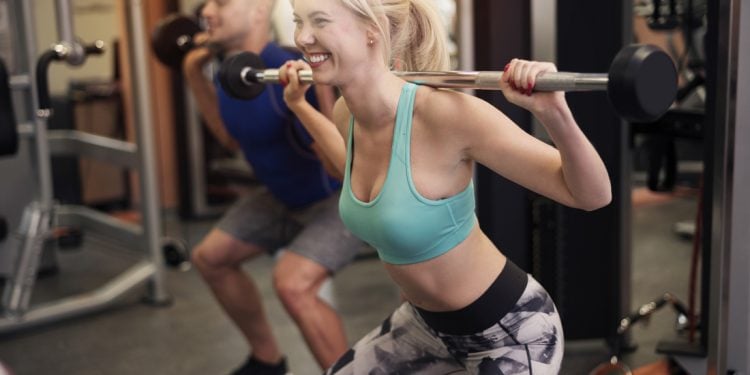Check out Aubrey Worek’s top exercises to build what she calls a million dollar backside!
I have had the pleasure of working with the general fitness population over the last 15+ years and one of the most common questions I have repeatedly gotten is, “How can I develop my glutes?” That is why I designed my top 7 Ways to Effectively Build Stronger, Larger Glutes workout.
Did you know that out of the 640+ muscles in the human body the gluteus maximus is the largest? It is also one of the most neglected muscles in the body. It has gained this distinction through improper movement patterns and lack of exercise. We spend more time sitting on our glutes than using them.
Coupled with movements that do not engage this muscle properly, atrophy soon follows. The first rule with this program is too consciously contract your gluteus maximus prior to beginning each exercises and neuro-muscularly keeping it actively engaged throughout the exercise.
These rules apply to all of my “Top 7.” The gluteus medius and minimus are also contributors to building a better backside and play a role in hip stabilization, abduction (raising the leg away from the midline of your body) and some forms of internal and external rotation at the hip.
Equipment Needed: 1 Kettlebell, 2 Dumbbells, and/or 1 Barbell, a step or bench that is 6 inches or higher and a light resistance band or tube. *Note: In order to select the ideal amount of weight start by being conservative, going lighter than you normally would. If weight training is completely new to you, please schedule a session with a certified personal trainer when going through this plan for the first time.
When starting any fitness program, it should begin with a physician’s Medical Clearance. Safety is the priority of any fitness program.
1. Warm-up: The warm-up is crucial to achieve the necessary flow of blood to the muscles in order to focus on growth. This will decrease the risk of injury to you during the more intense phases of this plan. You need consistent movement of 5 minutes or more that raises your heart rate. If you have any cardiovascular equipment that’s great for the warm-up, but if you don’t, you could march up and down stairs, walk laps around your living room…use your imagination.
As with all strength training programs, be sure to avoid holding your breath while lifting. Breathing is best when exhaling on the toughest part of the exercise. Don’t overthink it, just breathe! Last but not least, engage your glutes firmly. Visualize this muscle group contracting and tightening with each movement you make.
2. Band Squat + Side Steps – Not only are these great for core activation, better knee health, and quadriceps endurance, but they are great for activating your glutes too! Grab a band or exercise tube that you can tie around your upper thighs (avoid looping the band around the knee joint).
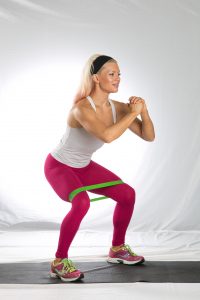 Band Squats
Band Squats
- Hold your squat position the entire duration. Your knees will be bent approximately 90 degrees or slightly less.
- Keep your spine elongated (do not round your back).
- Watch your form in a mirror and be certain that your knees are over your toes when stepping side-to-side. Your steps will be very small, just a few inches as you move. Take 8 to 12 little steps to the right and 8 to 12 little steps to the left. Then repeat.
- Use your outer thigh muscles (abductors) to keep good knee alignment by pressing into the band the entire time. Do not let the band have any slack in it – keep it tight. Tell yourself that resistance equals results!
- Bring the majority of your body weight into the heels of your feet (you should be able to wiggle your toes inside of your shoes).
3. Weighted Hip Thrusts– Weighted hip thrusts are very popular because people have an easier time “feeling” their glutes working. It makes sense because it forces you to engage your glutes at the top of the ROM (Range of Motion). I recommend using a weighted barbell for this exercise, a step bench or regular Olympic bench.
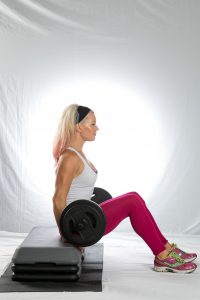
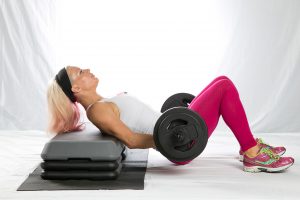
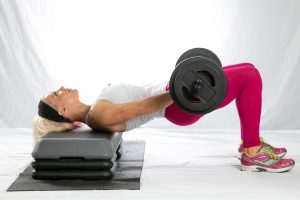
Tips to keep in mind when performing the Weighted Hip Thrust:
- Start with the barbell in your lap as you are seated upright on the bench.
- Slowly, begin to slide your hips off of the bench until scapulae (shoulder blades) and neck/head are supported on the bench, allowing your hips to drop towards the floor.
- Think of this as you would be performing a basic Bridge Pose (as in yoga) and keep your hips moving the entire time with a slight pause/extra contraction of the glutes at the top of the ROM.
- Keep the majority of your body weight in your heels. Again, you should be able to wiggle your toes inside of your shoes.
- 3 sets, 8-12 reps and the heavier you go, the more you can grow!
4. Curtsy Lunges– You can do this exercise with or without a step bench. The bench will make the movement more challenging from a balance standpoint and can help you increase your ROM. Omit the bench option if this causes you any knee discomfort or pain.
 Curtsy Lunge
Curtsy Lunge
- Place a barbell across the meaty part of your upper back, or hold two dumbbells by your side.
- Start on the top of the bench with your feet underneath your hips.
- Step your right leg back and crossed behind you onto the floor with your heel lifted.
- Squat down in a curtsy position.
- Keep your adductors (inner thighs) engaged tightly and both hip bones pointing straight ahead (a mirror is extremely helpful with this movement).
- Perform a total of 3 sets of 8 to 12 reps on each side.
- Try your best to center your shoulders and weight over the top of your hips.
- Engage your core, like you are wearing a breathable corset or cummerbund.
- Keep your back heel lifted and focus specifically on your back leg on going deep in your lunge.
5. Split Squats–When you execute the Split Squats (AKA: Bavarian Lunges) think as if your back leg is weightless and your back foot is there just to help with balance. Really focus on your front supporting leg as well as the glute on your front leg. Other important tips to keep in mind:
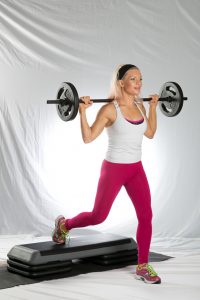
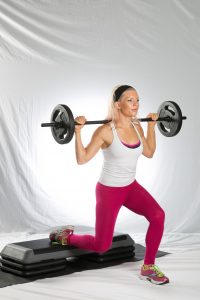
- If using a barbell, be sure to avoid resting it on your cervical spine (upper neck). The bar should rest more on your trapezius muscle (the meaty part of your upper back, just below your neck).
- The option of using a heavy dumbbell and holding it close to your midsection is another great variation.
- The starting position is on the floor, feet hip-width a part.
- When placing one leg on the step or bench, be careful you are not over crossing. You should feel like your stance is still hip-width, as if you were on a narrow set of train tracks – not a balance beam.
- You should be able to wiggle the toes in your front foot when performing this exercise, lunging up and down.
- Perform 3 sets of 8-12 reps.
6. Lateral Lunges– Start with your feet shoulder width apart. You have the option of using a heavy dumbbell and holding it at your midsection or placing two free weights on your shoulders. Inhale and then exhale as you step out to the right and shift your body weight over your right leg, squatting to a 90 degree angle at the right knee. Try to sit down with your hips, keeping your chest as upright as possible. Remember:
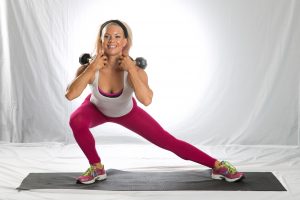
- To engage your core, breathe the entire time and keep your spine elongated.
- Watch your knees and make certain they are always pointed the same direction as your toes to avoid injury.
- Perform a total of 3 sets of 8 to 12 repetitions on each side, and enjoy!
7. Modified Single Leg Squat– This is an option on the single leg squat that is a body-friendly variation. It is still extremely effective for developing the gluteus maximus. Apply all of the following tips:
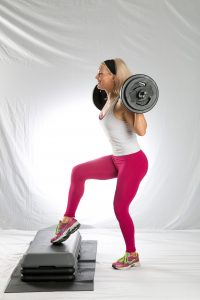
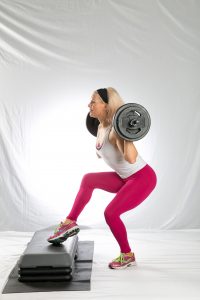
- Choose a barbell to place across your upper back or hold 2 dumbbells at your side.
- Sit back as deeply as you can. Pretend as if you are about to sit in a chair.
- Have minimal weight on the foot that is on the bench. You want to imagine as if someone could slide a piece of paper under the toes that are on the bench. This leg is helpful to keep your balance and will support you as you take your hips lower.
- Perform 3 sets of 8-12 reps on each side and concentrate on physically and mentally engaging your glutes. You will notice a difference in sensation when you become more aware of your body.
Now it is time for a brief static stretch. You need to release and stretch your hip flexors.
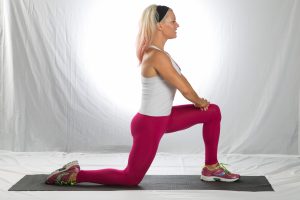
This can be performed both after your warm-up and after your workout. Hold each stretch for about 30 seconds for effectiveness.
Happy training to all of you who are working hard on keeping your glutes strong and healthy the old fashioned way – with hard-work, proper form and determination!
Best in health,
Aubrey Worek
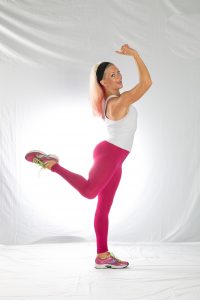
Glute Resource to Check Out:
For a scientific overview of the importance of glute training (it's not just for aesthetics after all!), check out this NASM roundtable youtube video on glutes.

